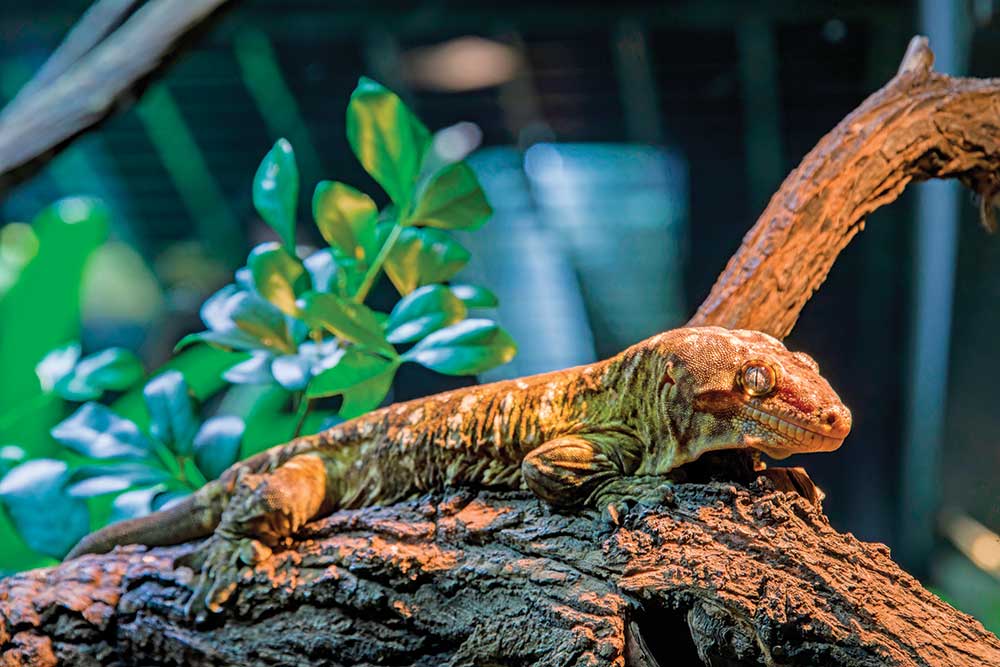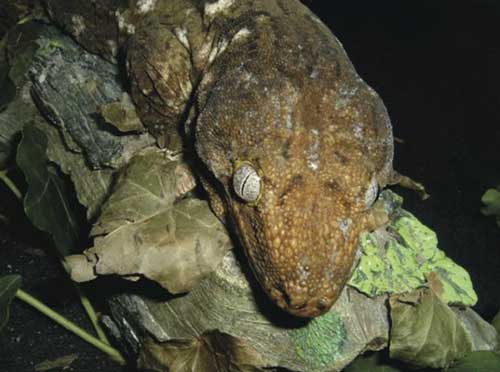One of the most spectacular and sought-after species of the Rhacodactylus genus is R. leachianus.
Updated February 1, 2023
New Caledonian Giant Gecko (Rhacodactylus leachianus ssp.)
One of the most spectacular and sought-after species of the Rhacodactylus genus is R. leachianus, with two subspecies that are presently recognized as giant geckos from New Caledonia, a group of islands northeast of Australia. They are Rhacodactylus leachianus leachianus, found on Grande Terre (GT), the largest New Caledonia island, and Rhacodactylus leachianus henkeli, found on Pine Island (Isle of Pines) and other smaller islands.
The huge size of R. l. leachianus makes for a very impressive lizard. Its coloration and patterns are more not as distinctive as that of R. l. henkeli. Its color ranges from various shades of browns, grays, and black with patterns ranging from transverse striping, white side-banding with black spots, or overall white blotching. The island morphs of R. l. henkeli are smaller but their vivid cryptic coloration makes them very appealing. Colors range from moss-like greens, browns and grays, to a blending of colors with blotches of pink and lavender, bands of orange, salmon or white with black spots.

New Caledonian giant gecko. Photo by Danny Ye/Shutterstock
These geckos have a large head, thick body and a short tail that is comprised of two distinct segments: a broad base and a short slender section, separated by a fold of skin. Many people confuse the original tail for one that has been regenerated. Under certain conditions, leachianus can detach their tails if threatened, startled or grasped by the tail. This defense mechanism does not harm the geckos, and their tails will regenerate, though they will look different than the original. They are not likely to lose their tails due to handling; more often, it occurs during quarrels with cagemates.
New Caledonian Giant Gecko Availability
Rhacodactylus leachianus were once extremely rare, with very limited availability, but due to an increase in successful captive breeding they have become more prevalent in the reptile trade. Because they take longer to mature to breeding age they are generally more expensive than other geckos, and availability is restricted due to the relatively low production of an average of two to five clutches of two eggs each year. For conservation reasons, they are no longer exported from New Caledonia.
New Caledonian Giant Gecko Size
Rhacodactylus l. leachianus is the larger of the two subspecies, and one of the largest geckos in the world. Adult size ranges from 14 to 17 inches, including the tail, and it can weigh 212 to 279 grams. Hatchlings are about 3 1/2 to 4 inches long, including the tail. Adult R. l. henkeli range from about 9 to 12 inches, including the tail, and they can weigh 115 to 250 grams. Newborn R. l. henkeli are about 3 to 3 1/2 inches long, including the tail.
New Caledonian Giant Gecko Life Span
New Caledonian giant geckos are hardy, and with proper care they may live up to 20 years or longer in captivity.
New Caledonian Giant Gecko Housing
A single adult leachianus can be housed in an upright screen enclosure no smaller than 18 by 18 by 24 inches tall (larger would be even better), or a 40-gallon enclosure with a screen top. Commercially manufactured enclosures with foam backgrounds and front-opening doors work well, too. It is best to house giant geckos individually, unless they are a breeding pair. Otherwise, they can become aggressive toward each other. If aggression occurs, separate them immediately.
Hatchlings and young juveniles can be housed in smaller enclosures, such as plastic shoeboxes with air holes or 1½-gallon Critter Keepers. They can be intimidated by enclosures that are too large. A simple setup is recommended, with just a small hide box or piece of cork bark, a shallow water bowl, and a small food dish. As juveniles grow, they can be moved to an intermediate enclosure, such as an upright screen enclosure or a 10-gallon aquarium with a screen top.
Because leachianus live in tree hollows in the wild, it is important to simulate this type of habitat in captivity. For adults, provide plenty of hiding places and climbing areas so the gecko feels secure. Cork bark tubes (which are durable enough to handle these large geckos), PCV pipe, bamboo, live or artificial foliage, plus a hide/egg-laying box, and a water dish should all be included. A secure hiding place is a must for these geckos. If live plants are desired, larger, sturdier types are recommended, as small plants will be crushed by these geckos.
New Caledonian Giant Gecko Lighting and Temperature
New Caledonian giant geckos are nocturnal and do not require lighting, although UVB lights can be used to simulate day and nighttime rhythms. Daytime ambient temperatures should range between the upper 70s and lower 80s Fahrenheit, and can drop into the low 70s at night. A low-wattage red bulb or undertank heater can be used if supplemental heat is needed to maintain this range. Fluorescent lighting can be used if live plants are in the enclosure. Turn off lights at night.
New Caledonian Giant Gecko Substrate
Substrate can consist of a high-grade mulch or peat-based potting soil. The hide/egg-laying box should be half-filled with vermiculite, potting soil, or moss. This needs to be kept moist all the time but not overly wet (otherwise, severe skin infections can occur, causing health problems).
For hatchlings, a paper towel substrate is recommended, which should be changed several times a week. Larger hatchlings can be placed on a clean mulch substrate.
New Caledonian Giant Gecko Food
Adults can be fed Repashy Superfoods’ Crested Gecko Diet, a fruit-flavored protein diet that is mixed two parts water to one part food, supplemented with vitamins and minerals. Offer this in a sturdy, shallow crock that cannot be easily tipped over. Remove uneaten food after 24 to 36 hours. This can be done two to three times a week. Fruit puree can also be offered, but you must supplement it before feeding.
To add variety, also offer crickets (sized according to the distance from the gecko’s eye to its mouth), waxworms or Dubia roaches several times a week. The larger R. l. leachianus is known to become increasingly insectivorous with age. Dust insects with a calcium/D3 and vitamin supplement according to manufacturer directions. Occasionally, a pinky mouse can be offered as a treat.
Hatchlings usually will not start eating until three to five days after they hatch, as they are still absorbing yolk. Start by offering them a few quarter-inch crickets, alternating with a commercial diet in a shallow dish three to four times a week. Crickets should be coated with reptile calcium/D3 and vitamins.
Because these geckos are nocturnal, it is best to feed them at night, when they are awake.
New Caledonian Giant Gecko Water and Humidity
All leachianus should have access to fresh water in their enclosures at all times. For hatchlings and juveniles, use a shallow dish. Larger dishes can be used for adults. The humidity level should be between 50 and 75 percent; use a hygrometer to keep track (these can be purchased at many pet shops). Mist the enclosure three to four times a week to maintain humidity, either by hand or using a commercial misting system. The enclosure should be moist but not overly wet.
New Caledonian Giant Gecko Handling and Temperament
New Caledonian giant geckos may or may not allow handling, depending on the individual gecko. Hatchling R. leachianus should not be handled until they are 2 to 3 months old, as they need time to acclimate to their habitat. Hatchlings are very flighty and will jump, but with intermittent gentle handling they will calm down. Do not hold a gecko tightly, but let it grasp on to you. If it starts to jump, control can be maintained by using the hand-to-hand technique (let it jump onto one hand, then the other, etc.).
To handle larger leachianus, approach with caution and remove them from their enclosure by quickly grasping the gecko behind the neck area while supporting its feet with your other hand. If the gecko feels threatened by your intrusion into its territory, it may lunge or attempt to bite, which can be quite painful due to the lizard’s strong jaws. Once you’ve got one out and feeling secure, though, it will usually calm down.
Julie Bergman is the owner of Gecko Ranch, LLC and has been breeding many species of geckos for over 20 years. She is a frequent contributor to REPTILES magazine and is the author of the Advanced Vivarium Systems book, Geckos. You can visit her website at www.geckoranch.com.
Robbie Hamper and her husband, Don, are the owners of Elegant Reptile Images, and they maintain one of the largest collections of Rhacodactylus leachianus in the U.S. They have worked with them for more than 45 years and have bred R. leachianus, leopard geckos and crested geckos for more than 20 years. Robbie has also written two books: Leopard Geckos in Captivity and Crested Geckos in Captivity.


